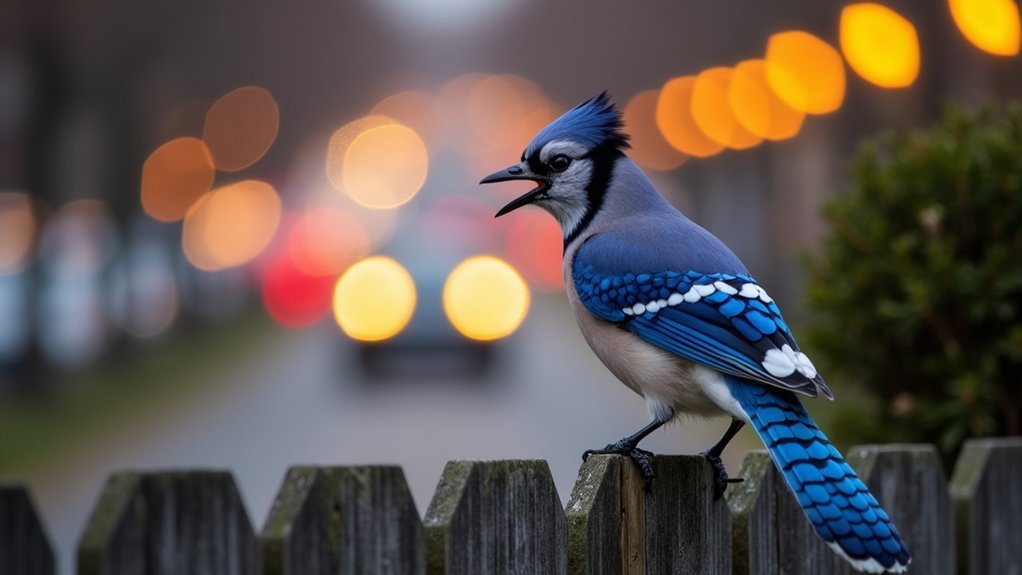Traffic noise masks birds’ natural songs, forcing them to adapt their vocalizations. You’ll notice urban birds singing at higher pitches to compete with low-frequency traffic sounds. They’ll also shorten their songs and adjust timing to avoid peak noise hours. Oscines (vocal learners) adapt more successfully than suboscines with genetically-fixed songs. When roads close temporarily, birds quickly revert to their natural tunes. These adaptations reveal the hidden ecological impact of our urban soundscape.
The Urban Symphony: How Traffic Creates Acoustic Challenges

While humans may adapt to urban noise with noise-canceling headphones or by turning up the volume, birds face a more existential challenge. In cities, traffic noise creates a constant low-frequency backdrop that directly competes with birds’ communication channels.
Urban noise is more than an inconvenience for birds—it’s an existential threat to their fundamental communication systems.
You’ll notice this acoustic competition has forced our feathered neighbors to develop altered songs—shorter melodies with narrower frequency ranges—just to be heard above the din.
This urban noise pollution doesn’t merely annoy birds; it threatens their fundamental ability to attract mates and defend territories. For species like the Eastern wood pewee, these song modifications aren’t just minor adjustments but survival-critical adaptations.
When roads temporarily close, you can witness birds quickly reverting to their natural songs, revealing how directly traffic impacts their communication strategies.
Songbird Adaptation Strategies in Noisy Environments
You’ll notice distinct adaptations in urban songbirds as they shift their songs to higher pitch ranges to combat traffic noise interference.
These remarkable birds also employ simplified song structures with narrower frequency ranges, sacrificing complexity for better signal transmission through the urban soundscape.
When traffic subsides, even temporarily, birds quickly revert to their natural songs, revealing the strategic flexibility they’ve developed to survive in our increasingly noisy cities.
Subheading Discussion Points
Despite facing significant acoustic challenges, songbirds have developed remarkable adaptation strategies in response to urban traffic noise. You’ll notice these birds alter their songs in specific ways when traffic noise causes communication difficulties:
- They shorten their songs and reduce frequency ranges to improve transmission through noisy environments.
- Suboscines like the Eastern wood pewee raise their minimum frequencies to avoid competing with low-frequency traffic sounds.
- During temporary road closures, birds quickly revert to natural song patterns, demonstrating their adaptability.
- These modifications represent a trade-off, as higher-pitched songs may be less effective to attract mates.
These acoustic adjustments highlight the resilience of urban birds, though they come with potential reproductive costs that emphasize the importance of noise pollution reduction efforts.
Pitch Shifting Techniques
These remarkable adaptation strategies reveal the sophisticated mechanisms birds employ to overcome urban noise challenges. When you’re near busy roads, you’ll notice birds raising their song’s minimum frequencies to avoid competing with low-frequency traffic noise. This adaptation guarantees their songs remain audible despite the urban cacophony.
| Species Type | Adaptation | Impact |
|---|---|---|
| Oscine Songbirds | Higher pitch, shorter songs | Compromised mate attraction |
| Suboscine Birds | Limited frequency adjustment | Reduced territory defense |
| Eastern wood pewee | Modified song structure | Trade-offs in communication |
Birds demonstrate impressive plasticity in their vocalizations. When noise levels drop during road closures, they’ll quickly revert to their natural song structure with broader frequency ranges. This flexibility highlights the delicate balance between communication effectiveness and environmental adaptation in the face of human-generated noise pollution.
Urban Song Simplification
While adapting to noisy urban environments, songbirds have developed a remarkable strategy of simplifying their vocal repertoires. This urban song simplification helps birds overcome the masking effects of traffic noise that would otherwise drown out their complex melodies.
When you listen to birds in cities, you’ll notice these adaptations:
- Shorter songs with fewer notes and syllables to guarantee clarity
- Higher minimum frequencies that avoid overlap with low-frequency traffic noise
- Narrower frequency ranges that concentrate vocal energy where it’s most effective
- Less complex melodies that sacrifice mating attractiveness for basic communication
During road closures, you’ll hear birds quickly revert to their natural, more complex songs, demonstrating how traffic noise directly impacts birds’ ability to communicate effectively in urban settings.
Suboscine Birds vs. Oscine Birds: Different Responses to Noise
You’ll notice stark differences in how birds respond to urban noise based on their vocal learning abilities.
While oscines adapt their complex songs through learning and can modify frequency and amplitude to overcome traffic noise, suboscines like the Eastern wood pewee struggle with their innate, simpler songs that can’t be easily adjusted.
This fundamental distinction explains why suboscines often resort to singing shorter, lower-frequency songs in noisy environments, potentially compromising their mating success and territorial defense capabilities.
Vocal Learning Differences
Not all birds respond equally to the challenges of urban noise pollution, as evidenced by the stark contrast between oscine and suboscine species. The eastern wood pewee, a suboscine bird, highlights this vulnerability as it struggles to adapt its song types when faced with anthropogenic noise.
While oscines possess remarkable vocal plasticity, suboscines face significant limitations:
- Suboscines produce innate rather than learned songs, making them less adaptable to changing acoustic environments.
- They lack anatomical features necessary for effective frequency and amplitude adjustments.
- Their songs become shorter with reduced frequency ranges in high traffic conditions.
- Their communication deficiencies impact critical behaviors like mating and territory defense.
This fundamental difference in vocal learning ability suggests suboscines may face greater long-term consequences from our increasingly noisy urban environments.
Adaptation Rates Compared
Compelling evidence from recent field studies reveals stark differences in how quickly birds adapt their songs when confronted with urban noise challenges.
You’ll notice that oscine birds demonstrate remarkable plasticity, rapidly modifying both amplitude and frequency parameters when traffic noise interferes with their communication.
In contrast, suboscines like the Eastern wood pewee show notably slower adaptation rates. These birds, with their innate rather than learned songs, make only limited adjustments—singing shorter songs with narrower frequency ranges when traffic noise increases.
Their biological programming simply doesn’t allow for the same flexible responses that oscines exhibit.
This adaptation gap highlights a critical conservation concern: while oscine species can quickly evolve communication strategies for noisy urban environments, suboscines may face greater long-term population challenges as traffic noise continues to expand into natural habitats.
Song Complexity Variations
While both bird groups face the same urban soundscape challenges, their divergent song structures and learning mechanisms lead to dramatically different adaptability outcomes.
You’ll notice these distinctions when comparing their responses to traffic noises:
- The Eastern wood pewee and other suboscines produce innately programmed, simpler songs that show limited flexibility when confronted with urban noise.
- When exposed to traffic noises, suboscines typically respond with shorter songs and reduced frequency ranges rather than dynamic adjustments.
- Oscine birds can modify song complexity, amplitude, and timing more effectively to overcome acoustic interference.
- Song complexity differences between these groups directly impact their reproductive success in noisy environments, with suboscines potentially facing greater communication challenges.
This fundamental contrast in adaptation ability may determine which species thrive in our increasingly noisy cities.
The Science Behind Bird Song Modifications
When traffic roars through natural habitats, birds don’t simply sing louder—they fundamentally restructure their songs. Studies reveal that birds like the Eastern wood pewee raise the minimum frequencies and shorten their songs to overcome traffic noise interference.
| Adaptation | Purpose | Effect | Example |
|---|---|---|---|
| Higher pitch | Avoid low-frequency traffic noise | Reduced frequency range | Suboscines shift minimum pitch |
| Shorter duration | Increase transmission success | Less complex songs | Truncated melodic patterns |
| Altered rhythm | Fit songs between noise bursts | Modified song structure | Compressed song elements |
| Reversible changes | Temporary adaptation | Return to normal in quiet | Songs normalize during road closures |
You’re witnessing remarkable behavioral plasticity when birds modify their songs. These adaptations demonstrate their resilience, though they come at a cost—compromised communication effectiveness for mating and territory defense.
Weekend Road Closures: A Respite for Feathered Vocalists

The adaptive behaviors birds employ come with significant costs to their communication effectiveness. Weekend road closures provide a promising solution, allowing birds to reclaim their natural vocal patterns when traffic noise subsides.
During these quieter periods, you’ll notice birds experiencing:
- Return to longer, more complex songs with broader bandwidths
- Enhanced ability to attract mates through more appealing vocalizations
- Improved territorial defense through clearer acoustic signals
- Potential population stabilization, especially for species like the Eastern wood pewee
Research on the Eastern wood pewee, which has declined by over 50% in seven decades, suggests weekend road closures could help slow this troubling trend.
These temporary measures benefit not only the birds but also provide residents with opportunities to experience the natural soundscape of their communities.
The Hidden Costs of Changing Tunes
Birds’ remarkable ability to adapt their songs comes with substantial biological costs that researchers are only beginning to understand. When you listen to birds adjusting their tunes in response to traffic noise, you’re witnessing a trade-off that may threaten their future.
Eastern wood pewees, for example, produce shorter songs with narrower frequency ranges when surrounded by vehicle sounds, potentially compromising their territory defense and mate attraction.
Similarly, red-winged blackbirds singing altered songs face increased physical difficulty producing these modified vocalizations.
While these adaptations help birds communicate in noisy environments, they’re paying a hidden price. The higher frequencies and modified patterns of these altered songs often reduce their attractiveness to potential mates, directly impacting reproductive fitness.
This subtle but critical consequence raises concerns about long-term population sustainability in noise-polluted habitats.
Conservation Implications for Urban Bird Populations

Although urban environments offer abundant food sources and nesting sites, the persistent challenge of traffic noise threatens the survival of many bird species that call cities home.
Consider the Eastern wood pewee, whose population has plummeted by over 50% in seven decades, partly due to communication difficulties.
Conservation efforts targeting traffic noise can help reverse these trends:
- Weekend road closures allow birds to temporarily revert to natural songs, improving mating success
- Creating quiet zones in urban parks protects essential habitat for noise-sensitive species
- Implementing sound barriers along high-traffic corridors reduces noise pollution in adjacent habitats
- Monitoring song adaptations helps identify vulnerable populations before their numbers decline significantly
You’ll play a vital role in these conservation efforts by supporting policies that prioritize quieter urban spaces for our feathered neighbors.
Frequently Asked Questions
How Does Traffic Noise Affect Birds?
Traffic noise disrupts your birds’ communication, forcing them to adjust their songs by shortening duration and raising frequencies. This affects their mating, territory defense, and compromises song learning abilities long-term.
Why Do Birds Change Their Song?
Birds change their songs so you’ll hear them above traffic noise. They’re adapting their communication to guarantee you can distinguish their calls when attracting mates or defending territories in noisy urban environments.
How Did the Behavior of the Birds Change Due to Noise Pollution?
When noise pollution increases, you’ll notice birds shorten their songs, reduce frequency range, and raise minimum frequencies. They’re making these changes to be heard, but it’s affecting their ability to attract mates.
Does Loud Noise Affect Birds?
Yes, loud noise definitely affects you as birds. You’ll change your songs, struggle to communicate with mates, and experience stress when exposed to traffic noise, which can ultimately threaten your survival and population numbers.
In Summary
You’ve seen how urban birds aren’t just passive victims of our noisy world—they’re actively adapting their songs to survive. While these adjustments showcase remarkable resilience, they’re not without consequences for mating success and community dynamics. As you consider urban development in your community, remember that creating quiet spaces isn’t just about human comfort—it’s essential for preserving the authentic voices of our feathered neighbors.





Leave a Reply